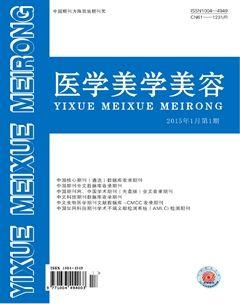TherelationshipbetweenmaxillarybuccallyTherelationshipbetweenmaxillarybuccally
LiuYing ChenJie XueQing LiuXin WangTao LiangShan-shan
【Keyword】Maxillarymalposedcanine;Sagittalfacialtype;Cephalo
【中圖分类号】R782.13【文献标识码】B【文章编号】1005-0019(2015)01-0049-02
Eruptiondisturbanceisafrequentlyobservedprobleminaseriesofprocessesthatresultsinconversionfromthedeciduoustothepermanentdentition.Themaxillarycaninesaresusceptible,theprevalenceofmaxillarybuccallymalposedcanine(MBMC)hasbeenreportedtobe27%inChinesedescent.Thepositionofcanineplaysanimportantrolefordentalarchmorphology.Eruptiondisturbanceorimpactedofmaxillarycaninesmayleadtomanykindsofproblemwhichincludethedestructionofintegrityofthedentition,archlengthshorter,poorocclusion,temporo-mandibularjointdisorders,andevenfacialappearanceandmentalhealth.Somestudieshavereportedtheinterrelationshipbetweenimpactedmaxillarycaninesandthemorphologyofthemaxilla.YoojunKimetal[1]showedtheshapeofthemaxillaryarchwasnarrowerandlongerinthepalatallyimpactedcaninegroupcomparedwiththebuccallyimpactedcaninegroup,andthepalatallyimpactedcaninegrouphadadeeperpalatalvaultthandidthebuccallyimpactedcaninegroup.TIANYu-louetal[2]foundthatimpactedmaxillaryanteriorteethmightresultinshortmaxillarybasalbone.AndtwocaninesimpactionhasthegreatestimpactonsagittalfacialtypeandtendstobeClassⅢfacialtype.However,therelationshipbetweenMBMCandsagittalfacialtypeisnotreported.Inthestudy,CephalometricanalysisforpatientswithlabialmaxillarycaninedislocationinordertoexaminetherelationshipbetweenMBMCandsagittalfacialtypeandevaluatethedentofacialmorphologicalcharacteristicsofpatientswithmaxillarymalposedcanines,providingatheoreticalbasisforclinicaltreatment.
MATERIALANDMETHODS
Atotalof50Chinesechildren(28girlsand32boys)withMBMC,wereselectedasfromthefilesoforthodonticpatientswhohadbeentreatedatourclinicsinTheAffiliatedHospitalofQingdaoUniversityinShandong,China.TheMBMCwasdeterminedbyclinical.AccordingtothenumbersoftheMBMC,subjectswereclassifiedtotwomaingroups(25casewithbilateralmalposed,25casewithunilateralmalposed).
Theageofthepatientsrangedfrom11to16years.Thesubjectswereselectedonthebasisofthefollowingcriteria:maxillarycaninesbuccallymalposed,allpermanentteethhaderupted,nopreviousorthodonticorprosthodontictreatment,andnocraniofacialanomalies,noprematurelossofdeciduousteeth(exceptthethirdmolars).
LateralpretreatmentcephalogramsweretracedforeachpatientwithWinceph8.0.Alltracingswereperformedby1investigatorandverifiedbytheother.Incasesofdisagreement,anew,mutuallyagreeduponlandmarkwasrecorded.Thenormalvaluesofthestudywerereferencedorthodontictextbook.
Anindependent2-samplettestwascarriedouttocomparethe2groups.StatisticalanalysiswasperformedbyusingSPSSforWindowssoftware(version17.0)
RESULTSCephalometricmeasurements(means±SD)inthe2groupswerecomparedwiththenormalandthecomparisonbetween2groupsofmeasuredvaluesintable1.Morestatisticallysignificantdifferenceswereobservedincomparisonwiththelattergroup.Theunilateralmaxillarybuccallymalposedcaninegroup(UMBMC),SNA,ANBislessthanthenormalvalue,thedifferencewassignificant(p<0.05),NA-PA,L1-NB(。)islessthanthenormalvalue,thedifferencewassignificant(p<0.05).ThebilateralmaxillarybuccallymalposedcanineGroup(BMBMC),SNA,ANB,L1-MP,LI-NB(。)Islessthanthenormalvalue,thedifferencewassignificant(p<0.05).U1-L1,U1-L1(mm)isgreaterthanthenormalvalue,therewasasignificantdifferenceinmeasurements(p<0.05).
Figure1.DiagramofcephalometricmeasurementTable1.Comparisonofcephalometricin2groups(X±s,n=25)
Mean1forUMBMC;Mean2forBMBMC
P1forcomparisonbetweenpatientswithUMBMCandnormal.
P2forcomparisonbetweenpatientswithBMBMCandnormal.
P3forcomparisonbetweenpatientswithUMBMCandBMBMC
NS,Notsignificant
NSIntheBMBMC,ANB,LI-MPislessthanUMBMC,thedifferencewassignificant(p<0.05).U1-NA,isgreaterthannormalvalue,therewasasignificantdifferenceincephalometricmeasurements(p<0.05).
DISCUSSION
Thecoordinationofthemaxillaandmandiblepositionrelationsisimportantfororthodontics,orthognathicsurgeryclinicaldiagnosisandtreatmentplanning.Currently,thesagittalskeletalpatternisdefinedbythethepositionalrelationshipbetweenthemaxillaryandmandibular.AccordingtonumericalsizeofANB,patientsweredividedintothefacialtypeofclassⅠ,classⅡandclassⅢ.Maxillaryandmandibularsagittalcoordinationimpactontheentirefacialappearanceandstomatognathicsystemfunctionsgreatly.Thefacialtyperelationshipinsubjectswithhypodontiaorcanineimpactionhasbeenstudiedpreviously.Ben-Bassatetal[4]showedthatpatientswithcongenitallymissingteethhaveacharacteristicskeletodentalpatternandanteriortoothabsencehasapredominantinfluenceontheskeletodentalconfiguration.Tavajohi-KermaniHetal[3]foundthatpatientswithcongenitalmissingteethcancausemaxillaryhypoplasia.WisthetalandSarnasandRunefoundthatthemaxillawasmoreretrognathicandshorter,andthesagittaljawrelationshipwassmallerthannormal.TIANYu-louetal[2]reportedthatimpactedmaxillaryanteriorteethmightresultinshortmaxillarybasalbone.Someotherstudieshaveconcludedthathypodontiahaslittleornoeffectoncraniofacialmorphology.[5、6]Littleisknown,however,abouttheassociationbetweenmaxillarymalposedcaninesandsagittalfacialtype.Theaimofthepresentstudywastoinvestigatetheassociationbetweenmaxillarybuccallymalposedcanineasandsagittalfacialtype.
ThestudyfoundthatSNA,NA-PAandL1-NBweresmallerthanthenormalvalueinthe2groups.ThissignifiesthattheMBMCcanresultinshortmaxillarybasalbone.TheMBMCcanindicateslackchewingfunction,meaningthatmightreducethegrowthofpromotingthegrowthanddevelopmentofalveolarjawaffectedtherebyfurther.
Convexity,L1-MP,ANBandWitsappraisalweresmallerwhileU1-NAandU1-NAweregreaterthanthenormalvalueintwogroups;L1-NBweresmallerwhileU1-L1wasgreaterthannormalvalueingroupofBMBMC.ThissignifiesthatMBMCshoweddislocationclassⅢskeletalpatterntrendisduetothelackofdevelopmentofthemaxilla.
AnotherangleU1-NA,U1-NAdistance,L1-NBangle,L1-NBdistance,changeL1-MPangleindicatorsshowtheupperandlowerfrontteethMBMCoccursinpatientswithupperandlowerfrontteethcompensatory,thusdisguisingfacetypeuncoordinatedduetoinsufficientdevelopmentofthemaxillacaused.
Thestudyshowthatmaxillarycaninesbuccallymisalignedmightresultinshortmaxillarybasalbone.TheBMBMChasthegreaterinfluencethantheUMBMConsagittalfacialtypeandtendstobeClassⅢfacialtype.
Conclusion
Thisstudysuggeststhatorthodontistsshouldfocusonfacialtypewhendiagnosisandtreatmentofpatientswithmaxillarybuccallymalposedcanine.Earlyattentionandearlytreatmenttoavoidmissingantreatmentopportunitybecauseofadelay.
Wemadethefollowingconclusionsfromthisstudy:
1.Madethelengthofmaxillarybasalbonereduced,showedatrendofclass3facialtype.
2.Twocomparedwithonegroup,theinfluenceonsagittalfacialtypeisgreater.
參考文献
[1]YoojunKim,Hong-KeunHyun,andKi-TaegJangInterrelationshipbetweenthepositionofimpactedmaxillarycaninesandthemorphologyofthemaxilla.AmJOrthodDentofacialOrthop2012;141:556-62.
[2]TianYL1,PiaoML,ZhaoZJ,Therelationshipbetweenmaxillaryanteriorimpactedteethandsagittalfacialtype.ShanghaiKouQiangYiXue.2014,23(1):99-102.
[3]Tavajohi-KermaniH,KapurR,ScioteJJ.Toothagenesisandcraniofacialmorphologyinanorthodonticpopulation[J].AmJOrthodDentofacialOrthop,2002,122(1):39-47.
[4]Ben-BassatY1,BrinI.Skeletodentalpatternsinpatientswithmultiplecongenitallymissingteeth.AmJOrthodDentofacialOrthop.2003,124(5):521-525.
[5]RoaldKL,WisthPJ,ThunoldK,BoeOE.Changesincraniofacialmorphologyofindividualswithhypodontiabetweentheagesof9and16.ActaOdontolScand.1982;40:65–74.
[6]YukselS,UcemT.Theeffectoftoothagenesisondentofacialstructures.EurJOrthod.1997;19:71–78.


